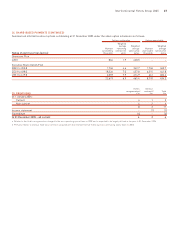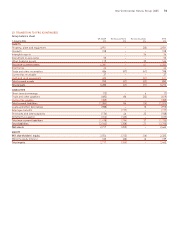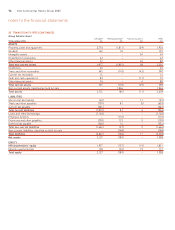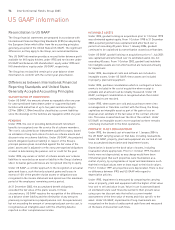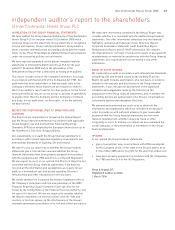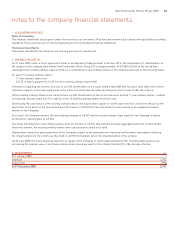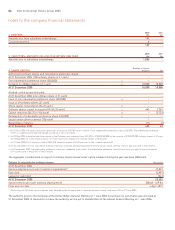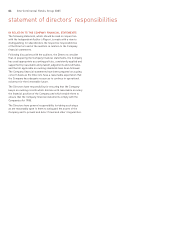Holiday Inn 2005 Annual Report Download - page 79
Download and view the complete annual report
Please find page 79 of the 2005 Holiday Inn annual report below. You can navigate through the pages in the report by either clicking on the pages listed below, or by using the keyword search tool below to find specific information within the annual report.
The Group recognises a profit on disposal of property, plant and
equipment provided substantially all the risks and rewards of
ownership have transferred. For the purposes of US GAAP, the
Group accounts for sales of real estate in accordance with FAS 66
‘Accounting for Sales of Real Estate’. If there is significant
continuing involvement with the property, any gain on sale is
deferred and recognised over the life of the long-term
management contract retained on the property.
Prior to the IFRS transition date, cumulative foreign currency
exchange gains and losses relating to the disposal of foreign
operations were adjusted within equity. Since 1 January 2004,
foreign currency gains and losses are included in determining the
profit or loss on disposal of foreign operations. At that date, the
Group opted to set the currency translation reserve to nil. Under
US GAAP, such gains and losses are also included in determining
the profit or loss on disposal but are tracked from the date of
acquisition of the foreign operation.
STAFF COSTS
The Group provides certain compensation arrangements in the
United States through a Rabbi Trust. Under IFRS, the net deficit
is recorded as a provision and the net change in the underlying
value of the assets and liabilities is recorded as a charge (or credit)
to the income statement. Under US GAAP, the marketable
securities held by the Rabbi Trust are accounted for in accordance
with FAS 115 ‘Accounting for certain investments in Debt and Equity
Securities’. The trust is shown gross in the balance sheet. The
marketable securities held by the trust are recorded at market
value and unrealised gains and losses are reported in other
comprehensive income except for other than temporary
movements which are recognised in the income statement.
DEFERRED TAX
The Group provides for deferred tax in respect of all temporary
differences between the tax base and carrying value of assets
and liabilities. Those temporary differences recognised include
accelerated capital allowances, unrelieved tax losses, unremitted
profits from overseas where the Group does not control remittance,
gains rolled over into replacement assets, gains on previously
revalued properties and other short-term temporary differences.
Under US GAAP, deferred tax is computed on all temporary
differences between the tax bases and book values of assets and
liabilities which will result in taxable or tax deductible amounts
arising in future years. Deferred tax assets under IFRS are recognised
to the extent that it is regarded as probable that the deductible
temporary differences can be utilised. Under US GAAP, deferred tax
assets are recognised in full and a valuation allowance is made to
the extent that it is not more likely than not that they will be realised.
Under IFRS, a deductible temporary difference arises in respect
of estimated future tax deductions on share-based payments based
upon the share price at the balance sheet date. Any excess of the
asset recognised over the cumulative compensation expense
recorded in the income statement multiplied by the statutory tax
rate is recorded directly in equity. Under US GAAP, a deferred tax
asset in respect of future deductible amounts is calculated only to
the extent of the cumulative compensation expense recorded to
date in the income statement. Where actual tax deductions received
upon exercise exceed the amount of any deferred tax asset the
excess is recorded in equity. Where actual tax deductions are less
than the deferred tax asset, the write-down of the asset is recorded
against equity to the extent of previous tax benefits recorded in this
account with any remainder recorded in the income statement.
DERIVATIVE FINANCIAL INSTRUMENTS AND HEDGING
The Group enters into derivative instruments to limit its exposure
to interest rate and foreign exchange risk. In 2004 under IFRS
transitional provisions, these instruments were measured at cost
and accounted for as hedges, whereby gains and losses were
deferred until the underlying transaction occurred. Under US GAAP,
all derivative instruments (including those embedded in other
contracts) are recognised on the balance sheet at their fair values.
Changes in fair value are recognised in net income unless specific
hedge criteria are met. The Group adopted both IAS 32 ‘Financial
Instruments: Disclosure and Presentation’ and IAS 39 ‘Financial
Instruments: Recognition and Measurement’ from 1 January 2005.
There is now no difference between IFRS and US GAAP with regard
to derivatives entered into after 1 January 2005.
GUARANTEES
The Group gives guarantees in connection with obtaining long-term
management contracts. Under IFRS, a contingent liability is not
recognised. For the purposes of US GAAP, under Financial
Accounting Standards Board Interpretation (FIN) 45 ‘Guarantors
Accounting and Disclosure Requirements for Guarantees, Including
Direct Guarantees of Indebtedness of Others in the Year’, at the
inception of guarantees issued after 31 December 2002, the Group
records the fair value of such guarantees as an asset and liability,
which are amortised over the life of the contract.
ASSETS AND LIABILITIES HELD FOR SALE
Under IFRS, assets and liabilities are classified as held for sale
when the criteria under IFRS 5 ‘Non-current Assets Held for Sale
and Discontinued Operations’ are met. Under US GAAP, similar
criteria are applied to held for sale assets. However, FAS 66
‘Accounting for Sales of Real Estate’ excludes any assets from
being included as held for sale where there will be a continuing
involvement in the asset.
DISCONTINUED OPERATIONS
Under IFRS, the results of operations arising from assets classified
as held for sale are classified as discontinued operations when the
results relate to a separate line of business or geographical area of
operations; or where there is a co-ordinated plan to dispose of a
separate line of business or geographical area of operations. Under
US GAAP, operations are classified as discontinued when they are
classified as held for sale and when the Group no longer believes
it will have a significant continuing involvement.
InterContinental Hotels Group 2005 77


